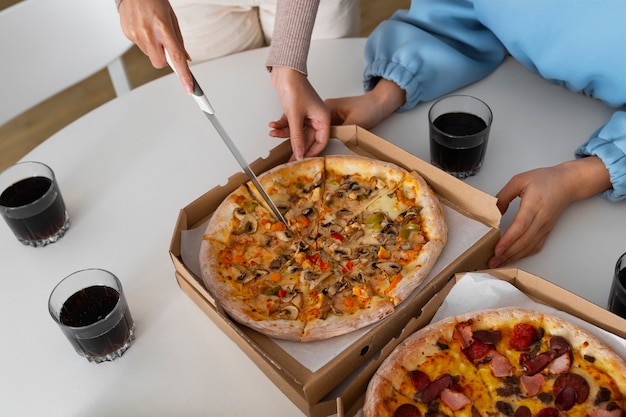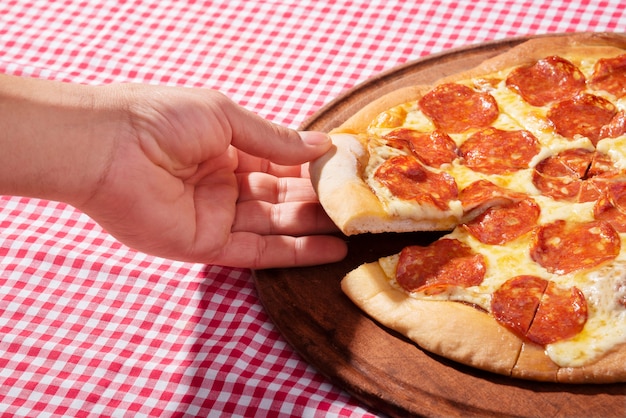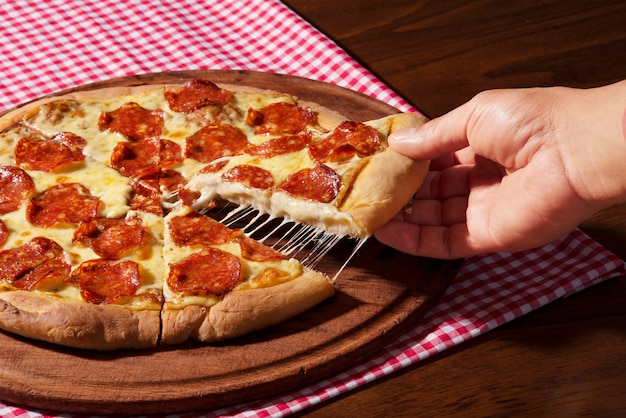Ah, pizza. The glorious, cheesy, saucy, doughy delight. But let's be real, a great pizza isn't just about the toppings; it's about that perfect crust. You know, the kind that's crispy, chewy, and slightly charred, with just the right amount of give. And guess what? It all comes down to one crucial factor: the oven temperature.
Now, I've been on a pizza quest for years, experimenting with different ovens and temperatures. I've had my fair share of burnt crusts, soggy bottoms, and even the occasional raw center. But through trial and error, I've learned a thing or two about nailing that perfect pizza oven temperature. Let's dive in.
(Part 1) The Importance of High Heat: Why It's Not Just a Hot Take

First things first, pizza ovens need to be hot. Like, seriously hot. We're talking temperatures that would make you reconsider your choice of footwear. Why? Because high heat is the secret weapon that gives pizza its signature crispness, those delightful char marks, and that melt-in-your-mouth cheese.
Why High Heat is the Key to Pizza Perfection
- The Perfect Crust: Imagine a thin, crispy crust that's both crunchy and chewy, like a symphony of textures. High heat is the conductor of this culinary orchestra, cooking the dough quickly and evenly to create that unforgettable crunch.
- Melty, Bubbly Cheese Dreams: High heat melts the cheese beautifully, transforming it into a gooey, bubbly masterpiece. Forget about that stringy, rubbery cheese you sometimes find on subpar pizza. We're aiming for cheesy nirvana here.
- Flavor Explosion: The intense heat caramelizes those toppings, bringing out their natural sweetness and enhancing their savory notes. It's like a flavor explosion in your mouth, with every bite a delightful surprise.
(Part 2) The Ideal Temperature Range: Finding the Sweet Spot

So, how hot is "hot" when it comes to pizza ovens? Well, for a proper pizza oven, the ideal temperature range is 450°F to 550°F (232°C to 288°C). This temperature zone is your happy place for achieving that perfect pizza.
Not All Pizzas Are Created Equal: Temperature Variations for Different Styles
Now, before you grab your pizza stone and blast your oven to 550°F, let's talk about different pizza styles. Not every pizza needs the same temperature. For example, Neapolitan pizza, with its thin, blistered crust and airy texture, is traditionally cooked at a blistering 900°F (482°C). This insane heat gives it that iconic charred edge and creates those beautiful air pockets in the crust.
But for most pizza styles, 450°F to 550°F is the ideal range for achieving a perfectly cooked pizza with a crispy crust and melted cheese.
(Part 3) Understanding Your Oven: The Good, the Bad, and the Ugly

Alright, let's talk about your oven. Now, every oven has its own personality, just like people. Some ovens are temperamental, while others are reliable workhorses. And understanding the capabilities of your oven is crucial for pizza success.
Home Ovens vs. Pizza Ovens: A Tale of Two Ovens
Home ovens are often the unsung heroes of the kitchen, but they're not always designed for the high-heat demands of pizza. A typical home oven might top out at around 500°F (260°C). So, while you might not be able to reach those scorching Neapolitan temperatures, don't despair. We'll unlock the secrets of making delicious pizza in a home oven later on.
On the other hand, professional pizza ovens are purpose-built for pizza magic. They can reach temperatures well over 900°F, thanks to their specialized heating elements and insulation. They're like the Ferrari of ovens, built for speed and performance.
(Part 4) Getting Your Home Oven Ready: The Preheating Ritual
Now, let's equip that home oven of yours for pizza greatness. It's all about patience and a little pre-game ritual. Preheat your oven to the highest setting for at least 30 minutes. This gives the oven time to reach its maximum temperature and heat up the pizza stone or baking sheet evenly.
Tips for Maximizing Heat in Your Home Oven: The Pizza Power Up
- The Pizza Stone: This is your best friend for achieving that crispy crust. A pizza stone absorbs and retains heat, creating a more even cooking surface for your pizza. If you don't have one, a baking sheet can work in a pinch.
- Preheating the Stone: Place your pizza stone or baking sheet in the oven while it's preheating. This allows it to reach the desired temperature and gives your pizza a head start.
- Avoiding the Oven Door: Resist the temptation to peek! Every time you open the oven door, you're letting precious heat escape. Keep it closed as much as possible during preheating and even during cooking.
(Part 5) The Pizza Oven Temperature Cheat Sheet: Navigating the Temperature Maze
Here's a handy cheat sheet to help you navigate the pizza temperature maze:
| Pizza Style | Oven Temperature |
|---|---|
| Neapolitan Pizza | 900°F (482°C) |
| New York Style Pizza | 500°F (260°C) |
| Chicago Deep Dish Pizza | 450°F (232°C) |
| Thin Crust Pizza | 550°F (288°C) |
Remember, these are just starting points. Experiment and adjust the temperature based on your oven and your personal preferences.
(Part 6) Knowing When Your Pizza is Done: The Signs of Pizza Perfection
How do you know when your pizza is cooked to absolute perfection? It's all about observation, a little intuition, and a dash of confidence.
The Tell-Tale Signs of a Perfectly Cooked Pizza: A Feast for the Senses
- Golden-Brown Glory: The crust should have a beautiful golden-brown color, with a few charming char marks on the bottom. This indicates that it's been cooked to perfection and is bursting with flavor.
- Bubbly Cheese Bliss: The cheese should be melted, bubbly, and slightly browned on top. It should look like it's about to burst with cheesy goodness.
- Cooked to Perfection: The toppings should be cooked through and flavorful, not soggy or raw. Every bite should be a symphony of textures and tastes.
(Part 7) The Art of Adjusting the Temperature: Tuning In to Your Oven
Sometimes, even with the perfect temperature, you might need to make a few adjustments. Think of it as fine-tuning your pizza orchestra for the perfect performance.
Adjusting for Different Ovens: The Fine Art of Oven Tuning
- Home Oven Adjustments: If you're using a home oven, you might find that you need to adjust the temperature slightly up or down to achieve the desired results. It's all about experimenting and finding what works best for your trusty oven.
- Pizza Oven Precision: Professional pizza ovens often have precise temperature controls, allowing you to dial in the exact temperature you need for different pizza styles. It's like having a temperature maestro at your beck and call.
(Part 8) The Importance of Pizza Stone Placement: Finding the Hot Spot
Here's a little pizza secret I learned the hard way: the placement of your pizza stone in the oven can make a big difference in the outcome of your pizza.
The Quest for the Hot Spot: Unleashing the Oven's Power
The hottest part of the oven is usually the bottom center. That's where the heat is most intense. Place your pizza stone in the bottom rack of the oven, and position it in the center to ensure even heating. If you have a bottom rack that's slightly lower than the other, use that one to maximize the heat.
Think of it like this: the bottom center of your oven is the heart of the pizza-cooking universe. You want to position your pizza stone in this prime location for maximum heat exposure.
(Part 9) Troubleshooting Common Pizza Problems: Solving the Pizza Puzzles
Let's be real, we've all had pizza disasters. We've all faced those moments of despair when the crust is undercooked, the cheese is stringy, or the toppings are a soggy mess. But fear not, my pizza-loving friends! I'm here to help you troubleshoot those common pizza problems.
Common Pizza Problems and Solutions: Fixing Those Pizza Mishaps
- The Undercooked Crust: If your pizza crust is undercooked, it might be because your oven isn't hot enough or you're not cooking it long enough. Try increasing the oven temperature by 25°F or cooking it for a few more minutes. You might also need to adjust your dough recipe if it's too thin or wet.
- The Burnt Crust: If your pizza crust is burnt, your oven might be too hot, or your pizza is getting too close to the heating element. Lower the temperature by 25°F or rotate the pizza halfway through cooking. You can also try using a pizza peel to lift the pizza slightly away from the stone to prevent burning.
- The Soggy Crust: A soggy crust is usually caused by too much moisture on the pizza, or the pizza being cooked on a cold surface. Ensure your dough is well-drained, and always preheat your pizza stone or baking sheet thoroughly.
- The Unevenly Cooked Pizza: If your pizza is unevenly cooked, it might be because your oven is not preheated properly or the stone isn't centered. Make sure your oven is preheated to the correct temperature, and center the stone in the oven. You can also rotate the pizza halfway through cooking to ensure even browning.
FAQs: Answering Your Burning Pizza Questions
Now, I know you might have some burning questions about this whole pizza oven temperature thing. So, let's address some common pizza quandaries.
1. What if I don't have a pizza stone?
No worries! You can still make delicious pizza without a pizza stone. Just use a baking sheet. Make sure it's preheated for at least 30 minutes to ensure it reaches the desired temperature. The key is to get that baking sheet nice and hot so it creates a crisp crust.
2. Can I use a gas oven for pizza?
Absolutely! Gas ovens can reach very high temperatures, making them great for pizza. Just make sure to preheat your oven thoroughly, following the manufacturer's recommendations for safe operation. You'll want to let the oven heat up for at least 30 minutes, or even longer, to ensure it's ready to cook your pizza perfectly.
3. How long should I cook a pizza at 500°F?
The cooking time for a pizza will vary depending on the size of your pizza and the thickness of the crust. A general guideline is to cook a 12-inch pizza for 10-15 minutes at 500°F. But remember, it's always best to keep a close eye on your pizza. You can check the pizza's progress by peering through the oven door or using a pizza peel to gently lift the edge.
4. What about using a pizza oven outside?
Outdoor pizza ovens are a fantastic way to enjoy pizza al fresco! They can reach even higher temperatures than home ovens, allowing for a perfectly crispy crust. Just be sure to follow the manufacturer's instructions for safe operation. Outdoor pizza ovens are a great way to elevate your pizza game and create a unique cooking experience.
5. Any tips for making a perfect pizza dough?
Absolutely! Here are a few tips to help you create a pizza dough that's both flavorful and easy to work with:
- High-Quality Flour: Look for a flour with a high protein content, such as bread flour or pizza flour. It will give your dough a more robust texture and help it hold its shape during cooking.
- Let it Rise: Patience is key! Let your dough rise for at least two hours, or even longer, to allow the yeast to develop its flavor and create a light and airy texture.
- Stretch It Gently: Don't be afraid to stretch your dough, but do it gently. Use your hands or a rolling pin to gently stretch the dough to your desired size. Overstretching can make the dough thin and brittle, so be careful!
And there you have it! A comprehensive guide to the perfect pizza oven temperature and everything you need to know to create that mouthwatering pizza masterpiece. Remember, it's all about experimentation, a little pizza intuition, and finding what works best for your oven and your personal preferences. So, get your oven preheated, gather your favorite toppings, and get ready to enjoy a pizza party!
Everyone is watching

Perfect Rice Every Time: The Ultimate Guide to Cooking Rice
Cooking TipsAs a self-proclaimed foodie, I've always been a bit obsessed with rice. It's the foundation of countless cuisi...

Prime Rib Roast Cooking Time Chart: Per Pound Guide
Cooking TipsPrime rib roast. Just the name conjures images of lavish dinners, crackling fires, and hearty laughter. It’s ...

The Ultimate Guide to Cooking Asparagus: Tips, Techniques, and Recipes
Cooking TipsAsparagus. The mere mention of this spring delicacy conjures up images of vibrant green spears, crisp and burs...

Ultimate Guide to Cooking the Perfect Thanksgiving Turkey
Cooking TipsThanksgiving. Just the word conjures up images of overflowing tables laden with delicious food, the scent of r...

How Long to Bake Potatoes in the Oven (Perfect Every Time)
Cooking TipsBaked potatoes are a staple in my kitchen. They're incredibly versatile, delicious, and surprisingly easy to m...
